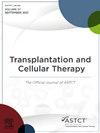多发性骨髓瘤患者在异体移植后复发的新疗法:多发性骨髓瘤患者在异体移植后复发的新疗法。
IF 3.6
3区 医学
Q2 HEMATOLOGY
引用次数: 0
摘要
背景:即使同种异体干细胞移植(allo-SCT)能治愈少数多发性骨髓瘤(MM)患者,但allo-SCT后复发的患者也能获得长期生存,这表明allo-SCT后服用的抗骨髓瘤药物与供体T细胞之间存在协同作用:我们回顾性评估了向 "Gruppo Italiano Trapianto Midollo Osseo e Terapia Cellulare"(GITMO)网络报告的、在2009年至2018年期间接受过异体造血干细胞移植的MM患者的预后,以确定全体患者(242例)的长期预后以及复发亚组患者(118例)的复发后总生存期(OS)延长的预测因素:结果:异体造血干细胞移植后的中位随访时间为40.9个月,整个人群的中位OS和无进展生存期(PFS)分别为39.4个月和19.0个月。非复发死亡率(NRM)的累积发生率(CI)在一年时为10.3%,五年时为27.6%。2-4级急性GVHD的CI为19.8%,中度或重度慢性GVHD的5年CI为31.8%。在多变量模型中,移植年龄较大(p=0.020)、异体造血干细胞移植前接受过两种以上的治疗(p=0.003)、非亲缘或单倍体供体移植(p=0.025)是降低OS的重要相关因素。118例(59%)患者在异体造血干细胞移植后复发,中位时间为14.3个月(IQR 7.2-26.9)。20名患者(17%)仅接受了类固醇、放疗或支持治疗,41名患者(35%)接受了1个疗程的治疗,23名患者(19%)接受了2个疗程的治疗,34名患者(29%)接受了3个或4个疗程的挽救治疗。9名患者只接受了化疗,9名患者接受了包括免疫调节剂(Imids)在内的至少一种挽救治疗,43名患者接受了包括蛋白酶体抑制剂(PIs)在内的至少一种挽救治疗,37名患者接受了包括单克隆抗体在内的至少一种挽救治疗(33种达拉单抗、1种艾洛妥珠单抗、1种异妥昔单抗、2种贝兰特单抗)。复发患者的中位生存期为异体造血干细胞移植后38.5个月,复发后20.2个月。在多变量分析中,同种异体移植后复发时间较长的患者(复发时间6-24个月,p=0.016;复发时间≥24个月,p< 0.001)和接受过至少3次挽救治疗的患者复发后的OS明显延长(p结论:在我们的研究中,在疾病的早期阶段进行移植并使用 HLA 相同的同胞供体的患者长期存活的机会最大。异体造血干细胞移植后晚期复发、多个疗程的挽救治疗以及与DLI的结合可使异体造血干细胞移植后复发的患者长期控制病情。本文章由计算机程序翻译,如有差异,请以英文原文为准。
Novel Drug Combinations and Donor Lymphocyte Infusions Allow Prolonged Disease Control in Multiple Myeloma Patients Relapsing after Allogeneic Transplantation
Although allogeneic stem cell transplantation (allo-SCT) is curative for only a minority of patients with multiple myeloma (MM), patients who relapse after allo-SCT can experience long-term survival, suggesting a synergy between antimyeloma drugs administered after allo-SCT and donor T cells. We retrospectively evaluated the outcome of MM patients reported to the Gruppo Italiano Trapianto Midollo Osseo e Terapia Cellulare (GITMO) network who underwent allo-SCT between 2009 and 2018, to identify predictors of long-term outcome in the whole population (242 patients) and predictors of prolonged overall survival (OS) after relapse in the subgroup of relapsed patients (118 patients). In the whole population, at a median follow-up of 40.9 months after allo-SCT, the median duration of OS and progression-free survival (PFS) were 39.4 and 19.0 months after allo-SCT, respectively. The cumulative incidence of nonrelapse mortality (NRM) was 10.3% at 1 year and 27.6% at 5 years. The cumulative incidence of grade II-IV acute graft-versus-host disease (GVHD) was 19.8%, and the 5-year cumulative incidence of moderate or severe chronic GVHD was 31.8%. In the multivariate model, older age at transplantation (P = .020), receipt of >2 lines of therapy before allo-SCT (P = .003), and transplantation from an unrelated or haploidentical donor (P = .025) were significant factors associated with reduced OS. Relapse after allo-SCT occurred in 118 patients (59%) at a median of 14.3 months (interquartile range, 7.2 to 26.9 months). Twenty patients (17%) received only steroids, radiotherapy, or supportive care; 41 (35%) received 1 line of salvage treatment; 23 (19%) received 2 lines of salvage treatment; and 34 (29%) received 3 or 4 lines of salvage treatment. Nine patients were treated exclusively with chemotherapy, 9 received at least 1 salvage treatment including immunomodulating agents, 43 patients were treated with at least 1 rescue therapy including proteasome inhibitors, and 37 patients received at least 1 salvage treatment including monoclonal antibodies (33 with daratumumab, 1 with elotuzumab, 1 with isatuximab, and 2 with belantamab). The median OS of relapsed patients was 38.5 months from allo-SCT and 20.2 months from relapse. In multivariate analysis, OS after relapse was significantly prolonged in patients with a longer time to relapse after allo-SCT (time to relapse 6 to 24 months, P = .016; time to relapse ≥24 months, P < .001) and in those who had received at least 3 lines of salvage treatment (P < .036) and donor lymphocyte infusion (DLI) (P = .020). In this study, patients who underwent transplantation in early phases of disease and with an HLA-identical sibling donor had the best chance of long-term survival. Late relapse after allo-SCT, multiple courses of salvage treatment, and an association with DLI could allow for long-term disease control in patients who experienced relapse after allo-SCT.
求助全文
通过发布文献求助,成功后即可免费获取论文全文。
去求助
来源期刊

Transplantation and Cellular Therapy
Medicine-Hematology
CiteScore
7.00
自引率
15.60%
发文量
1061
审稿时长
51 days
 求助内容:
求助内容: 应助结果提醒方式:
应助结果提醒方式:


